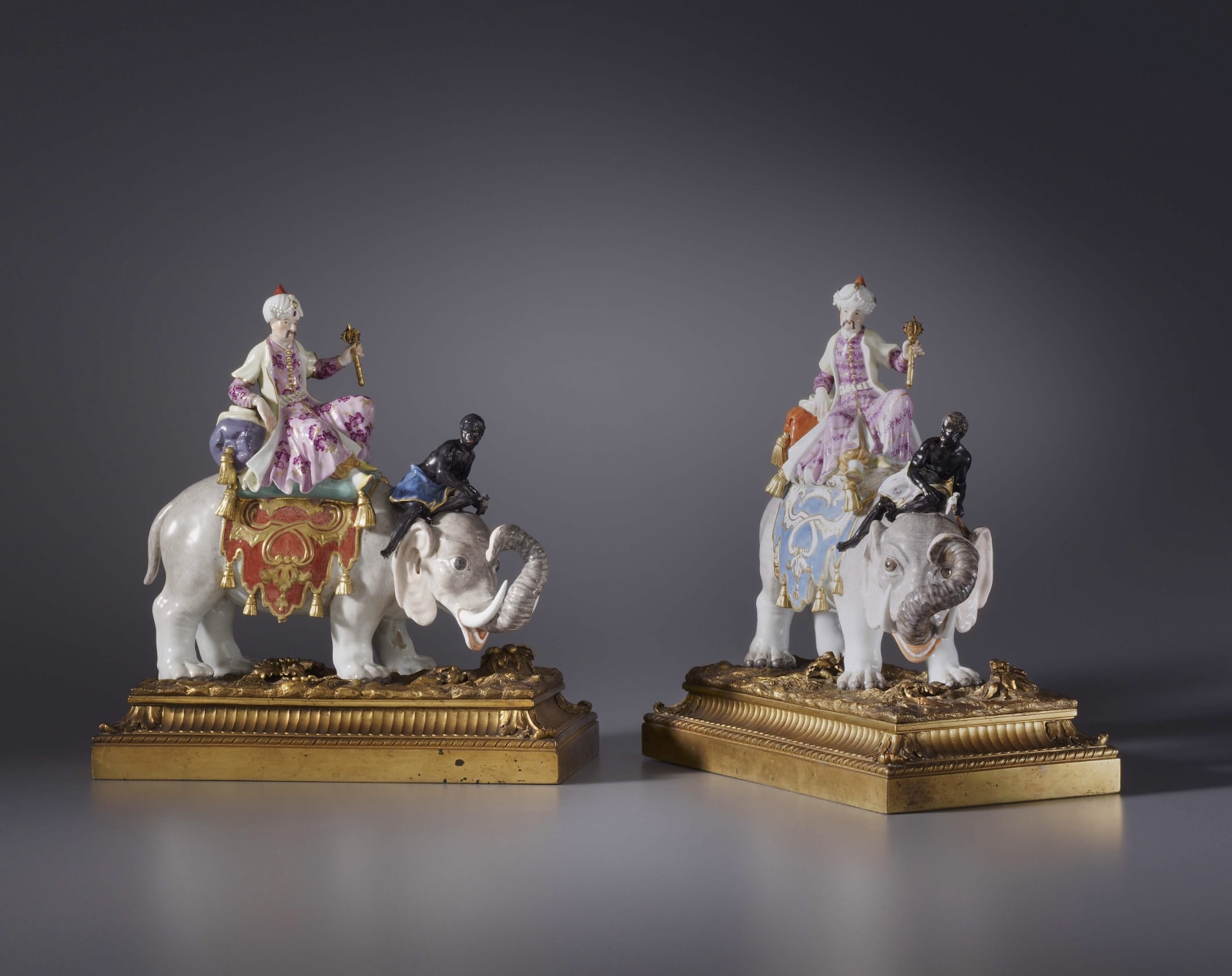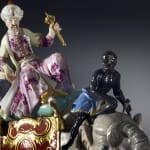Kändler
Literature
Geoffrey de Bellaigue, "The James A. de Rothschild Collection at Waddesdon Manor", 1974, p. 101, illustrating a pendule d'Éléphant, with case composed of an identical Meissen porcelain elephant supporting a clock, signed on the dial Gudin à Paris and surmounted by a Meissen putti personifying Autumn; noting that the porcelain expert Robert Charleston suggests the elephant was modelled by Peter Reinicke in 1743 and the figure of Autumn by Johann Joachim Kändler, 1741. Robert E Röntgen, "The Book of Meissen", 2000, pl. 54, illustrating an identical group without gilt bronze mounts, which the author notes as probably by Kändler and Reinicke, 1747-50. Pierre Kjellberg, "Objets Montés du Moyen Âge à nos Jours", 2000, p. 91, illustrating the same model as here but with variations to the painted decorations, which the author describes as an important Meissen group; with differing earlier Rococo mounts.
An important pair of Kändler period gilt and polychrome painted Meissen porcelain figurines probably by Johann Joachim Kändler and Peter Reinicke, each mounted on a Louis XVI gilt bronze base, each group composed of a white elephant with trunk held high, one with a pale blue and the other with a red saddle cloth, mounted by a figure of a moustached Persian nobleman wearing a long white coat over a splendid pink robe and holding a gilded mace in his left hand, above a Moor seated on the elephant's neck, one with a blue the other with a white loin cloth and both holding a hammer in his left hand, each elephant on a rockwork topped and stepped gadroon edged rectangular base
The porcelain: Meissen, date circa 1743-50.
The gilt bronze mounts: Paris, date circa 1775.
Height 31.5 cm, length 30 cm, depth 17 cm. each.
Evidence from literary documentation, cited above, indicate that these important Meissen groups were modelled by the factory's chief modeller Johann Joachim Kändler (1706-75) and one of his assistants Peter Reinicke (1715-68). Considered the greatest German porcelain modeller, Kändler was largely responsible for Meissen's success. Having trained as a sculptor in Dresden under B. Thomae, he joined the factory in 1731 and then worked as its chief modeller from 1733 up until his death. During this period he directed other of the factory's sculptors and also made models himself. One of his first projects was a series of large and highly naturalistic birds and animals for the Japanese Palace in Dresden. In addition to large-scale works, Kändler designed some of the factory's elaborate vases, played a role in designs for tableware, notably the Swan Service for Count Brühl and made numerous remarkable small-scale figurines. The latter included the famous Commedia dell-Arte actors as well as figures of Turks, Chinamen, shepherds, monkey musicians, pug dogs and other animals.
Kändler's chief assistants were the sculptors Johann Friedrich Eberlein and Peter Reinicke, the latter probably being responsible for the present elephant. Born in Danzig, Reinicke was employed at Meissen from 1743 up until his death and was responsible for assisting Kändler with Chinoiserie figures, the monkey Orchestra figurines and various portrait busts, while his independent models included elephants and other animals, Turks, Chinamen, Saints and some of the Commedia dell'Arte characters.
The vogue for elephants was very much part of the Rococo fascination with the exoticism of the Orient and may also have been inspired by early illustrations, of which one of the first was published in 1499 by Francesco Colonna, in "Hypnerotomachia Poliphili", which showed an Egyptian obelisk on the back of an elephant. Identical Meissen elephants were also made into supports for clocks, as evident from the example in the Rothschild Collection at Waddesdon Manor. In turn porcelain models were reproduced in bronze by some of the great eighteenth century bronziers, notably Jacques Caffiéri and Jean-Joseph de Saint-Germain. The present porcelain model was mounted slightly later in the eighteenth century since it is clearly of Neo-classical inspiration.



